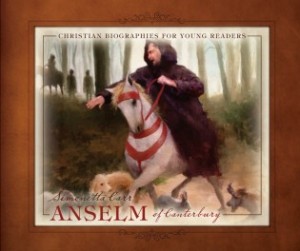Anselm Needs a New Hairdo

July 29, 2013
 Simonetta Carr, Anselm of Canterbury (Reformation Heritage Books, 2013)
Simonetta Carr has a delightful way of writing children’s books that parents are just as interested in reading themselves. She has done it again with another from the Christian Biographies for Young Readers series, Anselm of Canterbury. As soon as I opened my “major award” from the mail, I was eager to begin reading it to my son.
Maybe it’s just me, but I did find a little obstacle with this particular biography: the name “Anselm” just doesn’t roll of your tongue easily. I was a little afraid that it might turn my boy off to the whole story. Anselm, Anselm, Anselm…I just couldn’t say his name with enthusiasm. And he was born in Aosta in 1033. I don’t even know the proper way to pronounce that. Here I am stumbling over words as I read to my eight year old. Oh well, I’m human.
But quickly into the story I found relief. Anselm’s life is intriguing right from his early years. His mother whom he adored died during the formative years between childhood and adulthood. He wavered from once desiring to become a monk, to the licentious life of a rebellious young man. Carr explains that if you wanted to grow in knowledge during those days, you couldn’t turn to Google, books were very scarce, universities were not yet available, and of course, you couldn’t even make a phone call. Anselm was determined to travel over the beautiful yet dangerous Alps on a donkey to get some answers in life.
And this is when we finally got to a fun name. After years of persistent search, 26-year-old Anselm was very pleased with an Italian teacher named Lanfranc. Now that name is just plain enjoying to say. Haydn and I kind of made a game out of it every time I got to Lanfranc’s name in the story. His name was read with more gusto.
From here we learn about the beginnings of Anselm’s career in the church. He is blessed by God with a great compassion for people and the skill to teach complicated doctrines in a way everyone can understand. So much so, that he quickly rises from a monk, to prior, to abbot, author, and then archbishop of Canterbury. Lanfranc played a big role in Anselm’s life and growth. But after he died, Anselm was left to take his position and deal with the difficulties of working with the King.
Carr demonstrates well the complexities during this Middle Age period of history in the relationships between the rulers and the church. She also highlights the different expectations that the people put on the clergy at the time. Anselm really struggled with the political role of his position and had real conflict with the king over who appointed the church’s leaders. This struggle lasted most of his life, to the point where Anselm asked the pope to relieve him of his duties. The pope would not let him step down from his position, so Anselm persevered. Along the way we are introduced to other influences and supporters in Anselm’s life.
I was particularly pleased to learn about Matilda, Countess of Canossa. Not only was she a help for him to cross the Apennine Mountains, but a real encouragement for his cause. This encounter really made me think about the encouragement we can give to one another when we are just downright wearied by our fight for God’s truth. It may not seem like it sometimes, but God has many that he has called to serve his purposes alongside of us. People that God sends to encourage one another along the way are even more valuable than the coveted white bread that we learn about in the story, or the controversial fork that had just been introduced to eat your food with.
Carr does a fantastic job highlighting the struggles for the faith at this time period, once again lifting up a hero of church history by showing many of the colors of his life. It is through this messiness that we see God’s grace and providence as the real hero. The gospel message is declared with enthusiasm, we learn more about the history of the church, along with some interesting facts about the time period of Anselm’s life. I especially appreciated the excerpts from his writing at the end.
The illustrations are beautiful, as well as informative. Although, I don’t know what was up with the men’s hairstyles! Strangest balding pattern I've ever seen.
*Thanks to Reformation Heritage Books for the complimentary copy in exchange for my honest review.
Simonetta Carr, Anselm of Canterbury (Reformation Heritage Books, 2013)
Simonetta Carr has a delightful way of writing children’s books that parents are just as interested in reading themselves. She has done it again with another from the Christian Biographies for Young Readers series, Anselm of Canterbury. As soon as I opened my “major award” from the mail, I was eager to begin reading it to my son.
Maybe it’s just me, but I did find a little obstacle with this particular biography: the name “Anselm” just doesn’t roll of your tongue easily. I was a little afraid that it might turn my boy off to the whole story. Anselm, Anselm, Anselm…I just couldn’t say his name with enthusiasm. And he was born in Aosta in 1033. I don’t even know the proper way to pronounce that. Here I am stumbling over words as I read to my eight year old. Oh well, I’m human.
But quickly into the story I found relief. Anselm’s life is intriguing right from his early years. His mother whom he adored died during the formative years between childhood and adulthood. He wavered from once desiring to become a monk, to the licentious life of a rebellious young man. Carr explains that if you wanted to grow in knowledge during those days, you couldn’t turn to Google, books were very scarce, universities were not yet available, and of course, you couldn’t even make a phone call. Anselm was determined to travel over the beautiful yet dangerous Alps on a donkey to get some answers in life.
And this is when we finally got to a fun name. After years of persistent search, 26-year-old Anselm was very pleased with an Italian teacher named Lanfranc. Now that name is just plain enjoying to say. Haydn and I kind of made a game out of it every time I got to Lanfranc’s name in the story. His name was read with more gusto.
From here we learn about the beginnings of Anselm’s career in the church. He is blessed by God with a great compassion for people and the skill to teach complicated doctrines in a way everyone can understand. So much so, that he quickly rises from a monk, to prior, to abbot, author, and then archbishop of Canterbury. Lanfranc played a big role in Anselm’s life and growth. But after he died, Anselm was left to take his position and deal with the difficulties of working with the King.
Carr demonstrates well the complexities during this Middle Age period of history in the relationships between the rulers and the church. She also highlights the different expectations that the people put on the clergy at the time. Anselm really struggled with the political role of his position and had real conflict with the king over who appointed the church’s leaders. This struggle lasted most of his life, to the point where Anselm asked the pope to relieve him of his duties. The pope would not let him step down from his position, so Anselm persevered. Along the way we are introduced to other influences and supporters in Anselm’s life.
I was particularly pleased to learn about Matilda, Countess of Canossa. Not only was she a help for him to cross the Apennine Mountains, but a real encouragement for his cause. This encounter really made me think about the encouragement we can give to one another when we are just downright wearied by our fight for God’s truth. It may not seem like it sometimes, but God has many that he has called to serve his purposes alongside of us. People that God sends to encourage one another along the way are even more valuable than the coveted white bread that we learn about in the story, or the controversial fork that had just been introduced to eat your food with.
Carr does a fantastic job highlighting the struggles for the faith at this time period, once again lifting up a hero of church history by showing many of the colors of his life. It is through this messiness that we see God’s grace and providence as the real hero. The gospel message is declared with enthusiasm, we learn more about the history of the church, along with some interesting facts about the time period of Anselm’s life. I especially appreciated the excerpts from his writing at the end.
The illustrations are beautiful, as well as informative. Although, I don’t know what was up with the men’s hairstyles! Strangest balding pattern I've ever seen.
*Thanks to Reformation Heritage Books for the complimentary copy in exchange for my honest review. 



